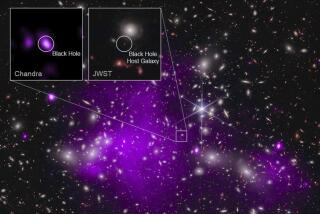Evidence of Massive Black Hole Discovered by Astronomers : Science: Team says the powerful object is as immense as 40 million suns. It was found using a series of radiotelescopes.
- Share via
TUCSON — Using a series of radiotelescopes stretching 5,000 miles across the United States from the Virgin Islands to Hawaii, an international team of astronomers has discovered strong evidence of an incredibly powerful black hole as massive as 40 million suns.
The findings, presented to the American Astronomical Society in Tucson Wednesday and published today in the journal Nature, is considered the strongest evidence yet of the existence of black holes, those mysterious objects that are so dense that not even light can escape their grasp.
“We think it’s a black hole,” said James Moran of the Harvard-Smithsonian Center for Astrophysics, one of the project’s leaders. “But this is not going to be the last word.”
It is difficult to prove the existence of black holes primarily because, by definition, they can never be seen. At best, scientists can only study the effects that would be expected in the surrounding territory if in fact a black hole is there. By several accounts, Moran’s project has come closer than any others.
“My mind is blown,” said galactic expert Vera Rubin of the Carnegie Institution. “I would say this is compelling evidence” of a black hole.
Paul vanden Bout, director of the National Radio Astronomy Observatory, which runs the radiotelescopes used in the project, made it clear that he believes the evidence:
“A jury would convict,” he said.
Scientists lust after evidence of black holes because they are among the most mysterious objects in the universe, devouring everything within their gravitational reach. Their immense pull is believed responsible for swirling masses of stars that radiate brilliantly across the heavens. A fuller understanding of black holes is considered essential to comprehending the physics that drives celestial objects from quasars to galaxies.
The discovery is the most stunning result to date from an extraordinary research tool that went into operation in 1993. The Very Long Baseline Array consists of 10 radio dishes, each 82 feet wide, scattered across the country. The array acts as a single telescope 5,000 miles wide, yielding a resolution so precise that a user standing in Los Angeles could read a newspaper in New York.
A team of Japanese and American astronomers made the discovery while studying a galaxy of stars 21 million light-years from Earth. The scientists suspected that a black hole lurked at the heart of the galaxy because radiation from that region of the sky indicated the presence of a tremendously powerful force. As they zeroed in on the suspect, they made a series of startling discoveries.
Captured throughout a thin disk of material swirling around the center of the galaxy were clusters of water molecules that performed a unique service for the astronomers. The water molecules were acting as masers--the cosmic cousins of earthbound lasers--capturing and amplifying radiation from the violent activity closer to the center of the galaxy.
The masers beamed intense radiation directly toward the Earth, serving as a series of powerful beacons orbiting the suspected black hole. The masers were found to be traveling at the astonishing speed of 650 miles per second.
Physics dictates that anything moving at such a speed would have to be orbiting around a very massive beast indeed.
Calculations showed the mass had to be equivalent to 40 million suns, more than 10 times greater than the mass of any other suspected black hole discovered so far.
Astronomers who “want to desperately avoid its being a black hole” could still argue that a tight cluster of perhaps 100 million stars could generate a gravitational field strong enough to cause the signature seen by the series of radiotelescopes, Moran said. However, those stars would have to be so close together they would probably collide in a stellar catastrophe, he said.
“It’s becoming quite challenging to the theoreticians to have a stellar cluster dense enough” to cause the observed effects, he added.
Moran said the speed at which the masers are orbiting the mass was determined by the Doppler shift, a change in frequency as they move toward or away from the Earth. He said he hopes to further confirm the findings in the coming years, actually measuring the speed of the masers over a long period of time.
That could be done only with an instrument as sensitive as the Very Long Baseline Array, he said.
Joining Moran in the presentation Wednesday were James Herrnstein and Lincoln Greenhill of the Harvard-Smithsonian Center for Astrophysics and Philip Diamond of the National Radio Astronomy Observatory in Socorro, N.M. Makoto Miyoshi, Naomasa Nakai and Makoto Inoue held a simultaneous presentation in Japan.
More on Science
* From the secrets of DNA to volcanoes on Venus, the TimesLink on-line service has a wide-ranging collection of articles on the sciences. Sign on and “jump” to keyword “science.”
Details on Times electronic services, B4






